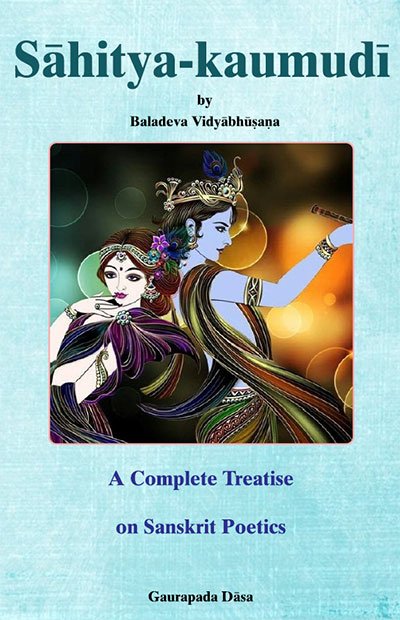Sahitya-kaumudi by Baladeva Vidyabhushana
by Gaurapada Dāsa | 2015 | 234,703 words
Baladeva Vidyabhusana’s Sahitya-kaumudi covers all aspects of poetical theory except the topic of dramaturgy. All the definitions of poetical concepts are taken from Mammata’s Kavya-prakasha, the most authoritative work on Sanskrit poetical rhetoric. Baladeva Vidyabhushana added the eleventh chapter, where he expounds additional ornaments from Visv...
Text 10.108
अथ श्लेषेऽपि दर्श्यते,
atha śleṣe'pi darśyate,
Now the paronomastic vyatireka is illustrated:
na candra-vat kalāḥ kṣīṇāḥ kalā-tantra-guros tava |
atas tvām abhilaṣyantī rādhā bādhā-śataṃ gatā ||
na—not; candra-vat—like [the kalās] of the moon [do]; kalāḥ—skills (or fractions); kṣīṇāḥ—wane; kalā—on the arts; tantra—of the scriptures; guroḥ—who are the teacher; tava—of Yours; ataḥ—because of this; tvām abhilaṣyantī—She who is desiring You; rādhā—Rādhā; bādhā—of obstacles (at the time of meeting in the middle of the night when there is no moon); śatam—a hundred; gatā—attained.
You are the guru of the scriptures on the arts. Your skills (kalā) do not wane like the fractions (kalā) of the moon. Therefore Rādhā wants You. Alas, She encounters hundreds of obstacles.
atrevārthe vatiḥ. kalā-śabdaḥ śliṣṭaḥ. tantra-gurutva-kṣiṇatvayor hetvor uktiḥ.
Here the suffix vat[i] has the sense of iva (like). The word kalā is paronomastic. Both types of reasons are mentioned: He is the guru of the Tantras, and the moon wanes.
Commentary:
Mammaṭa gives an example of paronomastic vyatireka with this usage of vat[i], jitendriyatayā samyag vidyā-vṛddha-niṣeviṇaḥ | atigāḍha-guṇasyāsya nābja-vad bhaṅgurā guṇāḥ || “The qualities (guṇa) of this man who has profound excellences and who, with controlled senses, properly serves knowledge and the elders are not ephemeral like the stalk (guṇa) of a lotus” (Kāvya-prakāśa verse 466).
